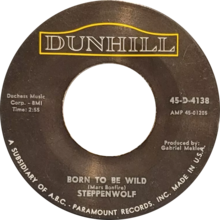| "Born to Be Wild" | ||||
|---|---|---|---|---|
 One of side-A labels of the US single | ||||
| Single by Steppenwolf | ||||
| from the album Steppenwolf | ||||
| B-side | "Everybody's Next One" | |||
| Released | May 9, 1968 | |||
| Genre | ||||
| Length |
| |||
| Label | ||||
| Songwriter(s) | Mars Bonfire | |||
| Producer(s) | Gabriel Mekler | |||
| Steppenwolf singles chronology | ||||
| ||||
| Official audio | ||||
| "Born To Be Wild" on YouTube | ||||
"Born to Be Wild" is a song written by Mars Bonfire and first released as a single by Steppenwolf. Although the lyrics do not specifically mention motorcycles, the song is often invoked in both popular and counter culture to denote a biker appearance or attitude since being featured in the 1969 film Easy Rider. Sometimes, "Born to Be Wild" is described as the first heavy metal song, and the second-verse lyric "heavy metal thunder" marks the first use of this term in rock music (although not as a description of a musical style but rather a motorcycle).[5][6]
- ^ Inglis, Ian (2003). Popular Music and Film. Wallflower Press. p. 13. ISBN 978-1-903364-71-0.
Steppenwolf's 'Born To Be Wild', a gritty, hard-rock song that quickly became an anthem for defiant individualism.
- ^ "Heavy Metal". Billboard. Vol. 99, no. 18. May 10, 1986. p. H-1. ISSN 0006-2510.
- ^ Dimery, Robert, ed. (2011). "The Pusher – Steppenwolf (1968)". 1001 Songs You Must Hear Before You Die. Octopus Publishing Group. ISBN 978-1-84403-717-9.
- ^ Hoskyns, Barney (1996). Waiting for the Sun: The Story of the Los Angeles Music Scene. Viking. p. 172.
The brilliant soundtrack, including the Byrds' 'Wasn't Born to Follow', Steppenwolf's proto-metal 'Born to be Wild', and Jimi Hendrix's 'If Six Was Nine', helped to set the film in a kind of outlaw-rock'n'roll context.
- ^ Dave Simpson (July 31, 2018). "How we made Steppenwolf's Born to Be Wild: Interview". The Guardian. Retrieved September 20, 2023.
- ^ Walser, Robert (1993). Running with the Devil: Power, Gender, and Madness in Heavy Metal Music. Wesleyan University Press. ISBN 978-0-8195-6260-9.